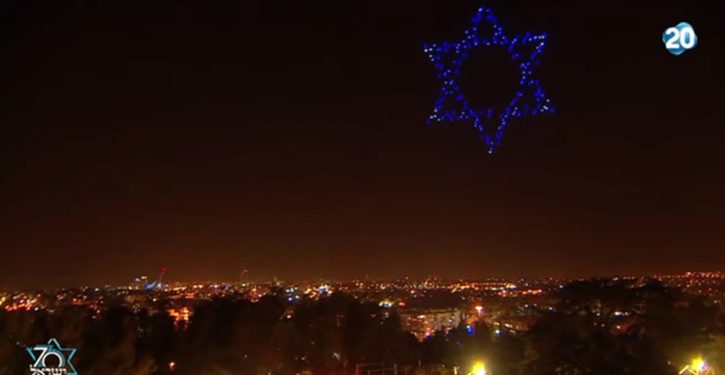
So what else is new? Israel celebrated the 70th anniversary of her declaration of independence on 18-19 April 2018, sunset-to-sunset, a day of both rejoicing and sober commemoration. The nation’s survival under constant threat has been a remarkable study in adaptability and courage.
Indeed, Israel has done far better than survive; Israel has thrived, in the 70 years since her re-founding, under inauspicious circumstances, on 19 April 1948.
In 2018, the greatest threat to Israel is from an Iran increasingly embedded in neighboring Syria and nearby Iraq. In February, for the first time, Iran sent a drone into Israeli air space apparently to function as a flying bomb. The drone, reverse-engineered from a U.S. drone Iran obtained in 2011, entered Israeli air space on 10 February 2018 laden with explosives, and operated at a very low altitude inside Israel for about a minute before being shot down by an IAF AH-64 Apache helicopter.
Will this presidential election be the most important in American history?
After this clear evidence of an intent to target Israel, the Israelis attacked Iranian targets in Syria, first immediately following the 10 February intrusion, and again on 9 April 2018. In the 9 April strike, made a few days before the announcement that the 10 February drone intrusion involved explosives, Israel attacked the Iranian facility at T4 air base in central Syria where the drone’s ground support and control elements were located.
Shortly after that second strike, on 13 April, the U.S. coalition launched the strikes on the Assad regime’s chemical weapons facilities in western Syria, near Homs and Damascus.
The Syrian regime claims to have shot down coalition missiles during that strike, although the U.S. Defense Department says no missiles were shot down (and has provided evidence of significant damage done to the intended Syrian targets by the coalition missiles; see here as well).
Syria has made at least one jittery response in the days since, on 17 April claiming that the regime’s air defense system was activated the previous night based on a false alarm, resulting in several anti-air missiles being fired. This announcement followed unconfirmed reporting of attacks near Homs and an air base in Damascus. Syria ultimately said there had been no outside attacks on those locations.
As Israel’s anniversary celebration commenced, the IDF was reportedly on high alert due to threats from Iran that a military attack – likely to be mounted by Iranian forces in Syria, rather than through proxies like Hezbollah – was forthcoming.
According to the Jerusalem Post:
Israel believes the attack will come in the form of precision- guided missiles or armed drones launched from a base in Syria by the IRGC itself – not by proxies, as was done before – under the command of Quds Force commander Maj.-Gen. Qassem Soleimani.
The IDF provided a map of the airfields through which Iran can flow weapons into Syria.

More on the weapons below.
A senior aide to Ayatollah Khamenei has been widely quoted issuing a warning to Israel:
Following the strike [on T4 air base on 9 April], Ali Akbar Velayati, the top aide to Iranian Supreme Leader Ali Khamenei, warned that Israel “should be waiting for a powerful response” to the strike on the airfield, saying “it will not remain unanswered.”
Iran is rattling the saber at both Israel and the U.S., in fact – an important key to the posture being adopted in Tehran. Iranian-backed militias in Iraq – the so-called Popular Mobilization Forces (PMF) – have made threats against U.S. forces operating there, and there has been at least one unconfirmed report of a PMF unit “laying siege” to a U.S. operating base after the 13 April strikes on Assad’s chemical weapons facilities. (The base appears to be a forward operating base in the Mosul area of northern Iraq.)
These threats are really renewals of threats made previously by PMFs to U.S. forces in Iraq (see here as well). But the new round of threats is a reminder that Iran continues to angle for destabilization on every front (including through Yemen, against Saudi Arabia). The situation is never a static one in which the threat to Israel is isolated from the surrounding dynamics.
Which is why two developments in the last 48 hours are of interest, and cannot be dismissed lightly. One is unconfirmed, but on balance, not as unlikely as it might seem.
Another Iranian drone attempt?
It’s a report from the Lebanese news outlet Ad-Diyar that Iran launched three explosives-laden aircraft toward Israel, apparently late on 18 or early on 19 April, and that a Russian aircraft from the air base at Hmeimim, near Latakia, intercepted them. The brief report from Ad-Diyar indicates that Russia basically would not allow Iran to expose the Syrian regime forces to retaliation by making such attempts. (It’s in Arabic, so most readers will need to run it through a translator.)
As Michael Pregent notes, Ad-Diyar is sympathetic to the Assad regime. Since Russia and Iran are both allies of Assad, it is at least of interest that Ad-Diyar would report something like this. There would be no obvious reason to publish it if Ad-Diyar didn’t have confidence in the validity of the information. But it’s also interesting, if we assume it is true, to consider why Ad-Diyar would put it out.
Pro Assad/Hezbollah site reporting Russia shoots down 3 Iranian aircraft loaded with explosives headed to Israel – likely BS – but a schism is developing between Tehran and Moscow https://t.co/JWaLkRhRXT
— Michael P Pregent (@MPPregent) April 19, 2018
At any rate, the story doesn’t actually say the Russian aircraft shot anything down. It says the Russian aircraft took off, and by implication responded to the flights of the three Iranian aircraft toward Israel. It sounds like the Lebanese outlet’s take is that the Russians intercepted the Iranian aircraft and (my estimate) forced them to turn around.
This could be credible in part because of where the report says it happened. The Iranian aircraft – which presumably were explosives-laden drones, like the one in February (the Arabic translates “aircraft with explosives”) – were said to be launched “from a plain between Daraa and Susa.” This probably means the flat land that lies between Daraa, Syria and the Kafr Sousa area of southwest Damascus.

Not only is this an area where Lebanese sources would have the ability to detect Iranian drone operations, it’s also the area the drone flew through in the February 2018 attempt on Israel.

Moreover, it’s an area in which Iran has been developing a military base for some time, just west of Al-Kiswah.


Israel attacked that base in December 2017. But the damage done then would not prevent Iran from reconstituting enough mobile infrastructure to operate a staging point for drones. (A good look at satellite imagery of the larger surrounding area shows a massive amount of military development, with apparent revetments, major digging projects, and numerous buildings that all bespeak a military purpose. At least two graded stretches could be used as dirt runways. Syria says the base is theirs, and is used for special forces – and it may be. But the likelihood is very high that Iran uses it too, and has been closely involved in its recent development.)
My assumption would be that the main Iranian drone facility would continue to be further inside Syria – out of reach of shorter-range Israeli capabilities – but that drones could stage through Al-Kiswah, and secondary, mobile command assets could be deployed there, for attempts against Israel.
We have no information to corroborate this Lebanese report. But it’s not infeasible. Lebanese observers would have been able to detect both the Iranian drone operations and the reported Russian reaction. The construction put on the Russian reaction is logical, but, again, unverified.
I mentioned after the 13 April strikes by the U.S. coalition that Russia would not see Assad’s chemical weapons facilities as a red line. Putin isn’t going to go to war with the U.S. to defend them. Likewise, he won’t be favorable to letting Iran jeopardize what Russia is getting out of her own position in Syria, by drawing Israel into a major defensive operation there.
That doesn’t mean Russia will be a reliable shield for Israel. It does mean there will be a limit to Iran’s freedom of action from Syrian territory.
The Iraq angle
So it is interesting, and not necessarily encouraging, to see the second regional development. This one involves Iraq. On 19 April, in the first such mission to be confirmed, F-16s from the Iraqi air force bombed ISIS targets in Syria, near Deir ez-Zor in the East. (Map below.)
بناءً على اوامر القائد العام للقوات المسلحة الدكتور حيدر العبادي نفذت قواتنا الجوية البطلة بمقاتلات F16 اليوم الخميس ضربات جوية مميتة ضد مواقع عصابات داعش الارهابية في سوريا من جهة حدود العراق .#IQAF#القوة_الجوية_العراقية pic.twitter.com/VPDRcr31Rh
— IRAQI AIR FORCE (@iqAirForce) April 19, 2018
Until now, the only Iraqi involvement in the fight in eastern Syria was reportedly that of PMF units, which occasionally were said to be operating on the ground near Al-Bukamal, just over the border from the Iraqi town of Al-Qaim.
Iraqi national army units had fought to eject ISIS from the approaches to Al-Qaim on the Iraqi side. But the Iraqi air force, taking off from the Balad Southeast air base, has now entered Syrian air space and conducted strikes in coordination with the Assad regime, and implicitly with Russia and Iran.
The coalition has a joint command center in Baghdad, as readers may recall. It was established in 2015, when Russia moved into Syria in force in the weeks after the Iran nuclear “deal” was announced (in July of that year). Significantly, as highlighted at The Drive, the Iranian defense minister was at their joint headquarters conferring with military leaders from the coalition countries while the Iraqi planes were conducting their strike mission.
https://twitter.com/samtamiz/status/986953292784787456
Iraq struck ISIS targets, reportedly near the town of Al-Shadadi, as seen on the map. The targets presumably were a tactical priority for the Assad-backing coalition. But they were also uncomfortably close to the territory held by the U.S.-backed Kurds (in yellow) northeast of Deir-ez-Zor.
Iraqi jets bombed ISIS outside al-Shaddi, Syria near the Iraq-Syria border Thursday. The strike was approved by Iraqi PM Haider Al Abadi: U.S.-led coalition statement
— Lucas Tomlinson (@LucasFoxNews) April 19, 2018

Up to now, Iraq has avoided coming too close to being truly embroiled in the military dynamics of the fight in Syria. That appears to be on the point of changing.
And that makes the map Michael Pregent has put together, depicting all the places where Iranian-backed PMF units act as armed enforcers throughout the Iraqi countryside, of particular importance.
We’re in Denial. IRGC-QF militias outnumber US advisors 20:1. They now have access to US funds & equipment. They have primacy over the ISF & are threatening to attack Americans. Their Fatah Party is set to win big on 12 May. They answer to Tehran & are commanded by Soleimani. pic.twitter.com/j2Z4QSF13N
— Michael P Pregent (@MPPregent) April 18, 2018
The potential exists for Iran to “activate” Iraq as part of the tactical Syrian battlefield, and not just a politically distinct logistical rear for it.
And that is in fact what I have been warning about with respect to Iran’s “land bridge” to Syria: not just that it’s a way for Iran to move forces from her western frontier to the Mediterranean, but that it’s a way to put all the territory in between in play, and create havoc, instability, and multiple vectors for coming at emerging targets – like Saudi Arabia, Jordan, potentially even Turkey, and, of course, Israel.
With the strikes on Assad’s chemical weapons facilities on 13 April, Trump set in motion dynamics that could drive a wedge between Russia and Iran.
Now Iran has just put a big hammer blow to a wedge between the U.S. and Iraq. In default of a positive U.S. goal in Syria – as opposed to the merely negative goal of destroying ISIS – it will become harder for us to maintain common interests with an Iraq that is effectively pursuing the same goals as Iran and Assad in Syria.
No one’s predictions about Trump and his effects in international affairs are really coming true, so we need to be careful about making them. I don’t assume he’s fated to fail on any trajectory that’s apparent to us; we see too little of what he really has in mind.
But from where we are right now, it’s not a given that Trump will be able to peel al-Abadi away easily from Tehran – even if the Iranians keep driving up the cost of Baghdad’s alliance with them.
A fighting push westward
This is where the point about Iranian weapons comes in. Back in June of 2017, Iran made a remarkable move and launched short-range ballistic missiles into eastern Syria from Iranian territory. The tactical effect was close to nil. But the strategic signal was unmistakable. Iran intended the entire territory from her border to Syria to be a fighting space, “held” for military exploitation purposes with missile envelopes, air defense, and surveillance as well as with troops.
That meant that Iranian military planners had a vision for a fighting approach to distant political targets; again, such as Saudi Arabia and Israel. The mental vision the Iranians have is not merely one of flying troops and equipment into forward bases, or assembling proxies there, and using missiles that overfly but do not “engage” nearer territories. Coupled with their occasional participation in the Syria fight with the Iranian air force, and their effective occupation of Iraq with Iranian-backed ground troops, it is clear that they intend to be able to mount military advances in all dimensions through Iraq.
Assets like tactical missiles and drones will be used for chewing up territory – consolidating control of it, establishing defense of it – and not just ferried across uninvolved, nominally neutral lines of communication to get to distant staging points.
For the regional nations, that becomes a problem different from what most Americans have had in their minds over the last five years. It’s actually more dangerous than the concept of Iran communicating on a long, tenuous logistics tether with vulnerable bases in Syria.
I composed this treatment at the time, with a few map depictions of how Iran might deploy missiles in exploiting and “fighting” Iraqi territory in a campaign approach toward Syria.
Two key points to round this out with are that (a) an all-dimension “fighting” push to the west would give Iran operational depth, in any approach to Israel (or another target on the same vector), that would make the approach much harder to interdict; and (b) it would develop in increments (although they could well be rapid ones), with Saudi Arabia, Jordan, and Israel all having to choose how much to tolerate as the threat grew both closer and better entrenched.
Unless Iraq is peeled away from Iran – and/or, of course, the radical regime in Iran falls, brought down by its disgusted people – there is a real possibility of, say, Jordan and Israel watching uncomfortably as Iranian missiles fall closer and closer to them. By the time the tactical missiles are falling too close, it may be more than the regional nations can do, to dislodge Iran from her campaign-gained operating territory. At least, it may be more than can be done decisively – or certainly without a major war.
We will see if Iran really tries anything big, soon, from a relatively vulnerable position in Syria, one in which Russia can restrain her and Israel can deliver retribution. The possibility can’t be discounted.
But the U.S. coalition strikes last week, and Israel’s recent strikes, along with the real possibility that Trump will pull out of the nuclear “deal” after May, have disrupted Iran’s previous momentum in the region. If Iran can’t administer meaningful blows to Israel with impunity, she may well turn that back over to the proxies for now.
It could be more useful for Iran to busy herself trying to reshape the environment in her favor again, by putting Iraq in play as more of the kinetic centrifuge Iraq was 6-7 years ago, instead of a “rear with the gear” backlot for the mullahs’ ambitions.
Israelis, meanwhile, managed to think about something besides security threats as they celebrated 70 years of independence. Here, courtesy of The Tower, portions of a spectacular light show put on by 300 Intel drones — surely, a form of entertainment and celebration no one could have imagined in 1948.




